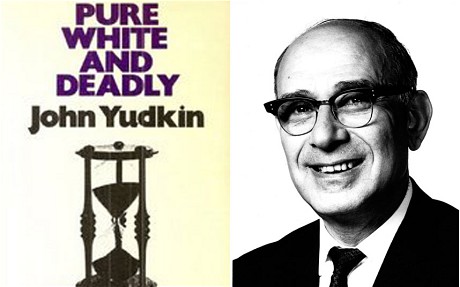Sugar Is A Legal High: Low Fat Makes You Fat And John Yudkin Was Right

REMEMBER the war on fat? Fat was bad. Now sugar is the target of the bansturbators. It’s is like “crack cocaine”.
“Nothing gets me high as that sandwich cookie does. But I love the filling most. I rub it on my roast, mix it in with my coffee, and spread it on my toast. I love the white stuff, baby. In the middle of an Oreo.”
Weird Al Yankovic said that in 1992.
The Atlantic noted:
That concept has been shown before, but remains important. In a 2010 study published in Nature Neuroscience, rats who spent 40 days eating bacon, sausage, cheesecake, and frosting—someone please market that combination; I mean please don’t—became “addicted.” They continued eating even in the face of electrical shocks. Non-addict rats did not. The researchers, at Scripps Research Institute in Florida, likened the brain activity in the addict rats to that of cocaine and heroin addicts.
Biscuits are legal cocaine? They’re a legal high. Ban them!
The HuffPost:
Sugar is the ‘most dangerous drug of our time’, according to a senior Dutch health official, and should be treated accordingly. Paul van der Velpen, head of Amsterdam’s health service, suggests that food and drink with high-sugar content should come with health warnings. He suggests introducing hard-hitting campaigns similar to the anti-smoking messages found on cigarette packets.
The BMJ approves:
The California Senate Appropriations Committee is deliberating a bill that would require drinks manufacturers to place the following warning label on all sweetened non-alcoholic drinks: “STATE OF CALIFORNIA SAFETY WARNING: Drinking beverages with added sugar(s) contributes to obesity, diabetes, and tooth decay.”1
Under the Sugar Sweetened Beverages Safety Warning Act (the first of its kind in the United States) these labels would apply to any such drink that “has added caloric sweeteners and contains 75 calories or more per 12 fluid ounces.” It would also require vending machines to bear warning labels and would allow for fines of $50 (£30; €37) to $500 (£297; €365) for failed inspections…
Many other potentially harmful products already carry effective health warnings. For example, insecticides and other toxic products have long carried labels warning users to take extreme care. Similarly, cigarettes have gone from being socially acceptable to quite unacceptable after warning labels were implemented. The effectiveness of tobacco warnings and plain packaging is now accepted by almost everyone not linked to the industry.2 These successes in tobacco control highlight the importance of targeting the “three As”—affordability, availability, and acceptability.

It started in the Sixties, as the Telegraph reports:
The tale begins in the Sixties. That decade, nutritionists in university laboratories all over America and Western Europe were scrabbling to work out the reasons for an alarming rise in heart disease levels. By 1970, there were 520 deaths per 100,000 per year in England and Wales caused by coronary heart disease and 700 per 100,000 in America. After a while, a consensus emerged: the culprit was the high level of fat in our diets.
One scientist in particular grabbed the headlines: a nutritionist from the University of Minnesota called Ancel Keys. Keys, famous for inventing the K-ration – 12,000 calories packed in a little box for use by troops during the Second World War – declared fat to be public enemy number one and recommended that anyone who was worried about heart disease should switch to a low-fat “Mediterranean” diet.
Instead of treating the findings as a threat, the food industry spied an opportunity. Market research showed there was a great deal of public enthusiasm for “healthy” products and low-fat foods would prove incredibly popular. By the start of the Seventies, supermarket shelves were awash with low-fat yogurts, spreads, and even desserts and biscuits.
But, amid this new craze, one voice stood out in opposition. John Yudkin, founder of the nutrition department at the University of London’s Queen Elizabeth College, had been doing his own experiments and, instead of laying the blame at the door of fat, he claimed there was a much clearer correlation between the rise in heart disease and a rise in the consumption of sugar. Rodents, chickens, rabbits, pigs and students fed sugar and carbohydrates, he said, invariably showed raised blood levels of triglycerides (a technical term for fat), which was then, as now, considered a risk factor for heart disease. Sugar also raised insulin levels, linking it directly to type 2 diabetes.
When he outlined these results in Pure, White and Deadly, in 1972, he questioned whether there was any causal link at all between fat and heart disease. After all, he said, we had been eating substances like butter for centuries, while sugar, had, up until the 1850s, been something of a rare treat for most people. “If only a small fraction of what we know about the effects of sugar were to be revealed in relation to any other material used as a food additive,” he wrote, “that material would promptly be banned.”
And now:
World Health Organisation guidelines say sugars should make up less than 10% of total energy intake per day for adults and children, but experts believe slashing this further to just 5% is more “ideal”. Dr Francesco Branca, of WHO, said “Five per cent is the ideal one and the 10% is the more realistic one. We have few countries (hitting) below 10%. But, yes, we should aim for 5% if we can.”..
He said taxes on sugary drinks were working in the USA, France, Hungary and Finland.
Simon Capewell, professor of clinical epidemiology at the University of Liverpool, UK, said: “Brits currently consume about three times too much sugar, 15% not 5%. This is because of the huge amounts of added sugars hidden in most processed foods: soups, yoghurts, ready meals, sugary drinks, fruit juices and smoothies.”…
Meanwhile, Labour announced it could ban children’s food that is high in fat, salt and sugar. Shadow Health Secretary Andy Burnham said: “We are going to have quite bold new thinking around children’s diets.”
Luciana Berger, Labour’s Shadow Public Health Minister, last night confirmed Labour’s plans. She said: “Labour shares the World Health Organisation’s concern about the amount of sugar in people’s diets. We believe there are too many products on shop shelves which are presented as healthier options but in fact contain high levels of sugar. Parents need to have confidence that the food they buy is healthy – especially cereal and fruit drinks marketed at children. This issue demands strong leadership. Labour is asking the public and experts about our proposals to introduce clear limits for sugar, fats and salts in children’s food.”
Amy Alkon takes up the tale:
The Dietary Guidelines for Americans–jointly published by the U.S. Department of Agriculture (USDA) and the Department of Health and Human Services (HHS) every five years–have had a profound influence on the foods Americans produce and consume. Since 1980, they have urged us to cut back on fat, especially the saturated kind found mainly in animal foods such as red meat, butter and cheese. Instead, Americans were told that 60% of their calories should come from carbohydrate-rich foods like pasta, bread, fruit and potatoes. And on the whole, we have dutifully complied.
By the turn of the millennium, however, clinical trials funded by the National Institutes of Health (NIH) were showing that a low-fat regime neither improved our health nor slimmed our waistlines. Consequently, in 2000 the Dietary Guidelines committee started to tiptoe away from the low-fat diet, and by 2010 its members had backed off any mention of limits on total fat.
Yet most Americans are still actively trying to avoid fat, according to a recent Gallup poll. They are not aware of the USDA’s crucial about-face because the agency hasn’t publicized the changes. Perhaps it did not want to be held responsible for the consequences of a quarter-century of misguided advice, especially since many experts now believe the increase in carbohydrates that authorities recommended has contributed to our obesity and diabetes epidemics.
Such a humbling reversal should have led the expert committee preparing the 2015 Dietary Guidelines, which holds its next-to-last public meeting Nov. 6-7, to fundamentally rethink the anti-fat dogma. But instead it has focused its anti-fat ire exclusively on saturated fats. Recent guidelines have steadily ratcheted down the allowable amount of these fats in the diet to 7% of calories “or less,” which is the lowest level the government has ever advised–and one that has rarely, if ever, been documented in healthy human populations.
The most current and rigorous science on saturated fat is moving in the opposite direction from the USDA committee. A landmark meta-analysis of all the available evidence, conducted this year by scientists at Cambridge and Harvard, among others, and published in the Annals of Internal Medicine, concluded that saturated fats could not, after all, be said to cause heart disease. While saturated fats moderately raise “bad” LDL-cholesterol, this does not apparently lead to adverse health outcomes such as heart attacks and death. Another meta-analysis, published in the respected American Journal of Clinical Nutrition in 2010, came to the same conclusion. The USDA committee has ignored these findings.
And – get this – we’re getting smarter (or dumber):
A study by the University of Aberdeen and NHS Grampian has found that children who grew up during the Second World War became far more intelligent than those who were born just 15 years before.
Researchers think that cutting rich, sugary and fatty foods out of the diets of growing children had a hugely beneficial impact on their growing brains.
Consequently, children born in 1936 grew up to have IQ scores on average 16.5 points ahead of those born in 1921.
Now. One lump or two?
Posted: 31st, October 2014 | In: Reviews Comment | TrackBack | Permalink


